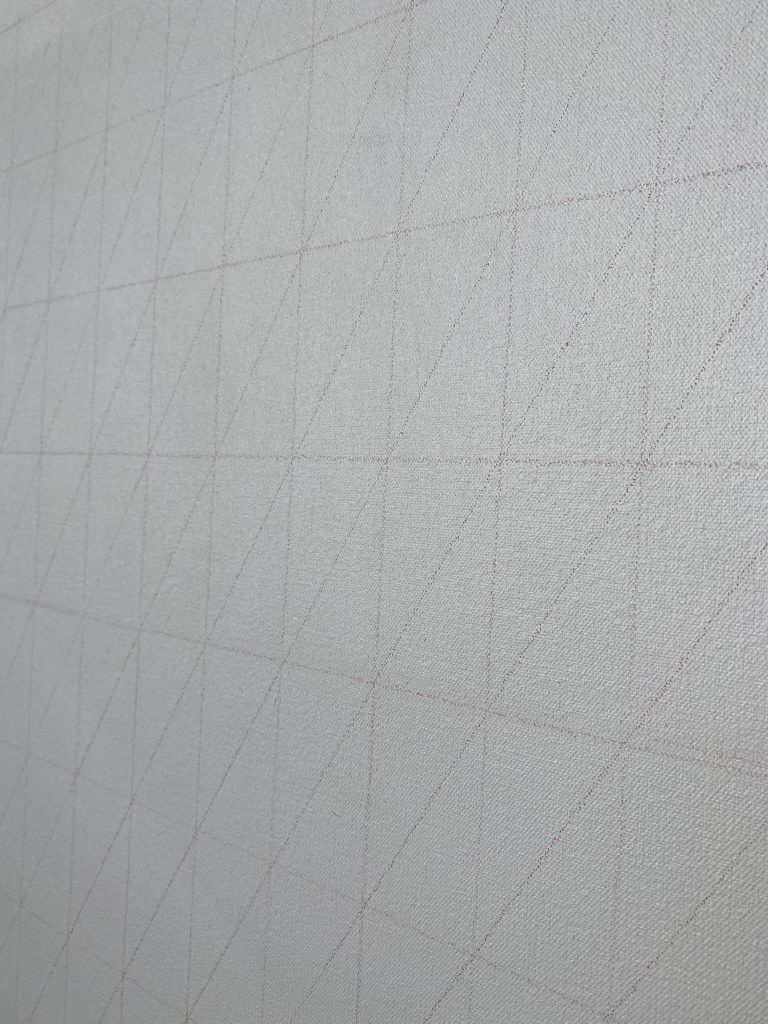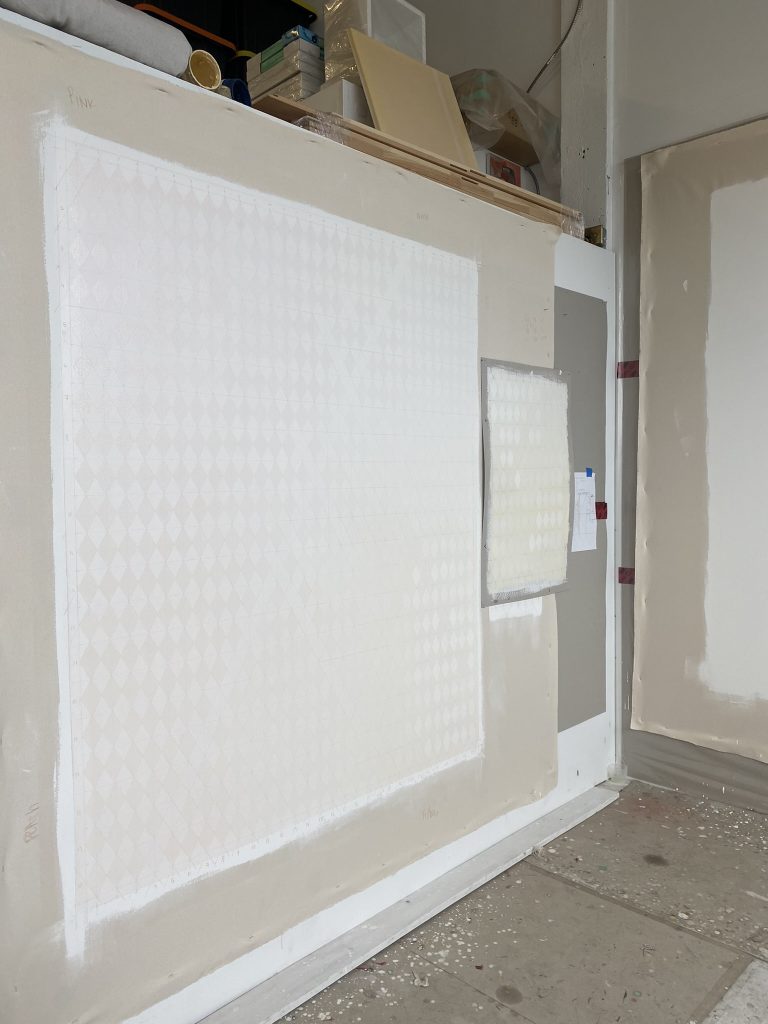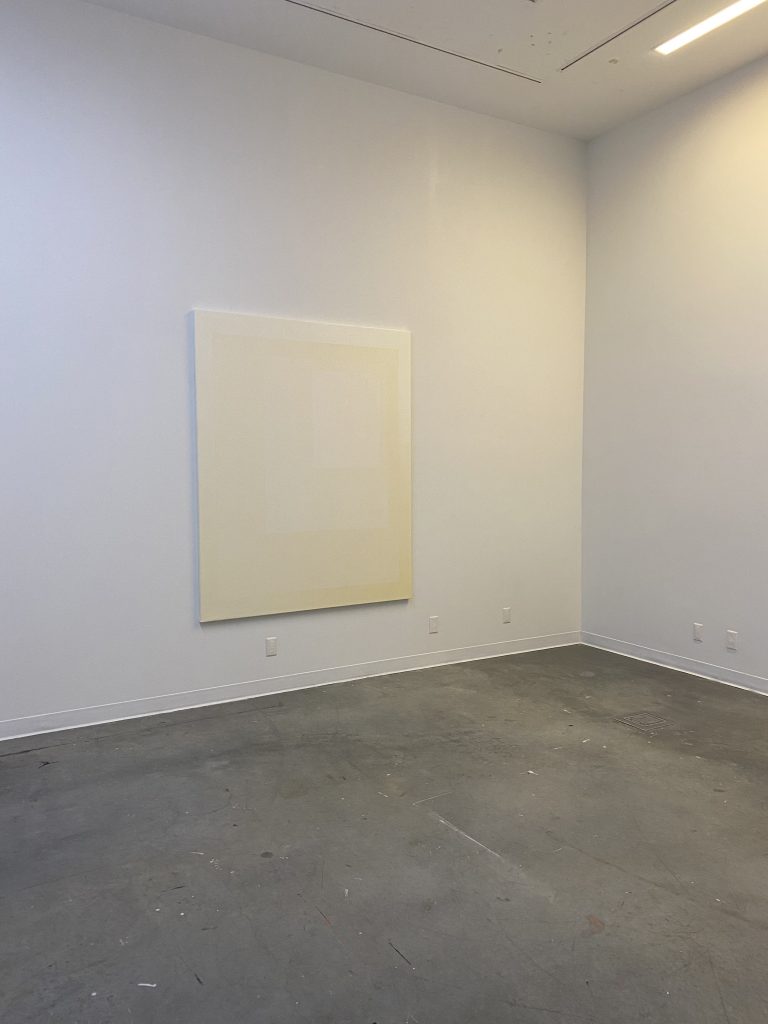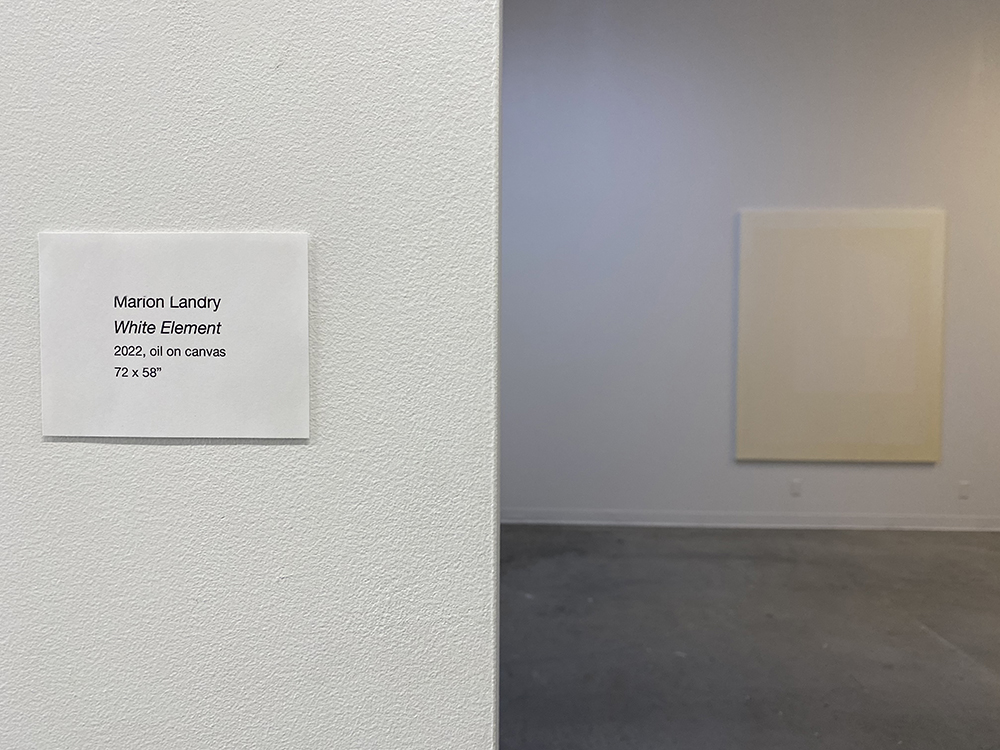Preparing for my final critique on April 8th, 2022
Painting description: Colours: 4 colours gradient of warm warm, pale yellow, pale peach, and pale pink. The foundation layer is super matte which was achieved using cold wax and mineral spirit as a medium. A 4 x 7cm grid was traced using a pink color pen. A grid was first laid out for the alignment and creation of the diamond shapes. 600 diamond shapes where hand painted using a glossy medium. The 4 colours gradient was shifted 90 degree when painting the diamond which helps created a slight contrast between colour rendering the pale colour more visible. Some of the diamonds where not painted breaking the grid rhythm as well as adding a hidden pattern.
– 140cm x 120cm
– oil on canvas.
– Almost white.
– Glossy and matte medium.
– Grid pattern 4 x 7 cm creating 600 diamond shapes.
Condition for installation: The painting will be installed in room B4130 – Senior Studio. This room offers a West facing wall as well as windows from floor to ceiling on the South Side allowing for the afternoon sun to land on the West facing wall. The same condition can be found at my Industrial Street Studio.
Viewing condition: The painting should be critique in the afternoon when the sun or natural light is shining on the wall and the painting. Because the painting has both matte and glossy surfaces, the natural light will animate the painting. The viewing angle will reveal different condition in the painting. When looking at the painting from the left side, the glossy diamonds will get animated by the light, might change colour depending on the weather condition caused by the reflection of natural light. The hidden pattern created by the omission to paint the diamond shape will offer a broader section of matte colour and will become more visible. When looking at the painting from the front, the diamond shapes will be almost non-visible. What will be visible from the front is the slight contrast of colour which will render the gradient more visible. The middle of the painting will become almost like a space or a vortex as the colour are almost the same and therefore disappearing within the space.
Documentation condition: Because it is hard to predict the weather for my final critique I will be documenting the light condition over a span of about 10 days. The documentation will be compile into a step motion video compiled from images captured ever 30 sec over a span of 4-5 hours. I am not sure if I will have sun or what the weather has in the forecast for me. However, all light condition will offer different viewing and atmospheric effect. The goal is to document different viewing angle and different light condition and have the videos (or one of the most successful video) played for the final critique and included in the conversation. This piece was created to be in conversation with the natural light and the atmospheric condition it creates.
Diamond pattern: The diamond pattern is one that I keep revisiting. This will be the forth time I use this pattern in a painting. It came to me during my month long residency in Athens, Greece in 2019. My main focus for the residency was to generate of series of paintings inspired by the geometrical patterns found in the Greek architecture and everyday life decor. Upon my first walk throughout the city my eyes captured the strong presence of the square as a foundational shape, both in architecture and decorative designs. The squares, sometimes organized into intricate grid patterns, are also often presented as lozenges inclined at a 45-degree angle, or squeezed slightly into diamond shapes. Two striking moments are worth the recollection when this pattern had a strong impact on me. First, the pavement in my neighborhood was meshed with this diamond pattern. Sidewalks is a big term for Athens; there are narrow and often used as parking so you are always looking down to step on and off it. In a lot of cases, the concrete or stone gets polished (glossy surface) in high traffic area and really dirty (matte surfaces) in other parts. As you walk and the sun hits the diamond pattern, the pavement shimmers is becomes more like an animated/moving surfaces. That was always so mesmerizing to me making my daily walk and activity so much more pleasant.
The other moment I observed this shimmering effect was at the Victoria train station. The architectural style of the station is Art Deco and the walls are covered with an hand made glazed light blue tiles. Over the years, some of the tiles have been replaced with a cheaper/mass produced version of the tile randomizing the blue tones. Upon entering and leaving the station, the tiles always shimmered and appeared to shift at a 45 degree angle.
Inspiration: The inspiration from this piece came from a recent trip to Magog, Quebec. This semester started a bit slow due to the latest scare of the omnicron virus. First, the school start was delayed by a week, then we where told that the first week would be online. I had been trying to find a way to go back to Montreal in mid-January to celebrate my dad’s 80th on January 17th and my Granny’s 100th on January 22nd. I couldn’t figure out how to pull it off without having major repercussion on my semester. Needless to say that this news, which came as a downer for most of my cohort, was received as an blessing for me. So I booked a flight to Montreal from the 16-23 of January. I was able to surprised my dad, shovel in hand, the morning of his birthday and help him shovel away the 16 inches of snow that had fallen overnight. What a surprise it was for him. Quebec was under very strict restrictions at the time and all restaurants and venues where closed. There was not much else we could do then enjoyed each other’s company. It was magic. Coffee and a walk with my dad in the morning and online school in the afternoon.
With my grandmother living in the eastern township, as well as my extended family, I aimed to be in Magog on Friday January 21st and visit her on the Saturday for her birthday. She had asked me to come in the afternoon so we had set the time for 1 pm. When I woke up in Magog that morning, it was the most exquisite sunny day but the thermometer indicated -32. I had not experienced that kind of weather in a very long time since I have been avoiding being in Quebec at this time of the years.
As I leaned over the window to look at the beautiful weather, a frequent but rare atmospheric phenomena happened. Diamond dust where floating all around the window. Diamond dust is a ground-level cloud composed of tiny ice crystals. Diamond dust generally forms under otherwise clear or nearly clear skies, so it is sometimes referred to as clear-sky precipitation. It is most commonly observed in Antarctica and the Arctic, but it can occur anywhere with a temperature well below freezing. And it happens in Quebec when the weather drops. I remember it from my childhood but I had not witnessed it in years. I stepped outside to be in it.
When you are outside at below -32, it hits you. You really need to dress up for it but you also need to be mentally prepared. When you live in Quebec, it becomes normal. You get used to it. When you don’t live there anymore, it hits you like a wall. Your nostrils stick together making it hard to breath. The cold air entering your lungs hurts so you want to breath it through your scarf. You need to cover most of your face other wise your skin hurts and your feet and hands freeze within about 5 minutes. It is highly recommended to move at all times.
BUT IT’S SO BEAUTIFUL AND WORTH IT! Diamond dust can only happened when it’s really cold and being immersed in it is magical. Diamonds float all around you. They don’t fall like snow flakes, they float and shimmer. Without any sunglasses, it’s hard to open your eyes in this brightness. You have to remembered that there is a foot of fresh snow on the crown and everything is white and so so bright that you open and close your eyes really quickly until you can somewhat get used to this brightness. Every time I opened my eyes, I was surrounded by this dance between light and weather condition. Light blue, pink, yellow and purple is shimmering around me. And for a moment, I forget, I get lost and taken to another dimension.















































